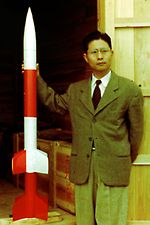The Baby Age
 |
Thus things were going smoothly
with rocket development in Japan, while, in Rome in spring 1954, a
meeting was held to prepare the 3rd IGY (International Geophysical
Year) for the first time after the end of the Second World War. The
IGY was a big project which was to try to clarify the global feature
of the earth under collaborative observation by scientists from all
parts of the world. The 3rd IGY was held under the powerful leadership
of the victorious nations (USA, UK and USSR) with rapid technical
innovation after the War for the background. The preparatory meeting
proposed two special projects; (1) antarctic expedition and (2) observation
of the upper atmosphere by sounding rockets. Among the participants
in this preparatory meeting were a group of Japanese scientists. US
scientists proposed that they use American sounding rockets, but they
fixed their eyes on the AVSA group. The AVSA group, which at first
aimed at developing high-speed space vehicles, was assigned the important
task of supporting Japanese scientists to join the 3rd IGY. |
Thus Japanese space development began to tread the thorny path with a
tight scram of space science and space technology from its very beginning.
The next rocket following Pencil was a two-stage Baby (8
cm in diameter, 120 cm in total length and 10 kg in total weight).There
were three kinds of Babies. Baby-S checked the flight performance by tracking
optically the thick smoke ejected from an onboard smoke-producing agent.
Baby-T was the first Japanese rocket to carry a telemetry
system.
Baby-R succeeded in retrieving onboard instruments. |


|
|